Southern Africa has a rich culinary history, showcasing a diverse range of past and present diets influenced by cultural, historical, and environmental factors. From traditional foods rooted in indigenous practices to the fusion of global influences in modern-day cuisines, the region offers a fascinating journey through time and taste.
Key Takeaways
- The staple food of Southern Africa, pap, is a corn porridge that became the basis of the modern black South African diet.
- Biltong, a dried meat jerky, originated with the indigenous Khoi people before being adopted by white settlers.
- Cape Malay cuisine, influenced by Dutch colonists and Javanese slaves, offers dishes like bredie and bobotie.
- Indian communities in South Africa have their own distinct curries, with Durban known for its hot mutton and prawn curry.
- South Africa also boasts a vibrant street food culture, with popular dishes like bunny chow and vetkoek.
Through exploring the past and present diets in Southern Africa, we gain a deeper understanding of the region’s culinary heritage and the cultural significance of food. Join us on this culinary journey as we uncover the flavours and traditions that have shaped Southern African cuisines throughout history.
Traditional Foods in Southern Africa
Traditional foods form the foundation of Southern African cuisine, with a variety of dishes embodying the rich culinary heritage of the region. The history of Southern African cuisine is a tapestry of cultural influences, indigenous practices, and colonialism, resulting in a diverse array of traditional foods that reflect the unique flavours and cooking techniques of each ethnic group.
One such traditional dish is Ugali, also known as Pap, a cornmeal porridge that is a staple in many Southern African countries. It is typically served alongside stews, braised meats, or vegetable dishes. Another traditional food is Bobotie, a curried meatloaf dish with Cape Malay origins. The fragrant spices and sweet flavours make it a beloved dish in South Africa.
“Food is central to our cultural identity and plays a significant role in our social gatherings and celebrations,” says Chef Nthabiseng Ramaboa, a South African culinary expert. “We have a deep respect for our ancestors and their traditional recipes, which have been passed down for generations.”
Culinary Traditions in Southern Africa
Each ethnic group in Southern Africa has its own culinary traditions and unique dishes. For example, the Zulu people have a dish called Isitambu, which is a thick maize porridge served with meat and vegetables. The Xhosa people are known for their Umngqusho, a flavorful stew made with samp (crushed corn kernels) and beans. And the Ndebele people enjoy Bobo, a traditional bread made from maize meal.
To truly experience the richness of Southern African cuisine, one must delve into the traditional foods that have been cherished for centuries. These dishes are not only delicious but also tell the story of the region’s history, culture, and resilience.
| Traditional Foods | Cultural Influences |
|---|---|
| Ugali (Pap) | Indigenous |
| Bobotie | Cape Malay |
| Isitambu | Zulu |
| Umngqusho | Xhosa |
| Bobo | Ndebele |
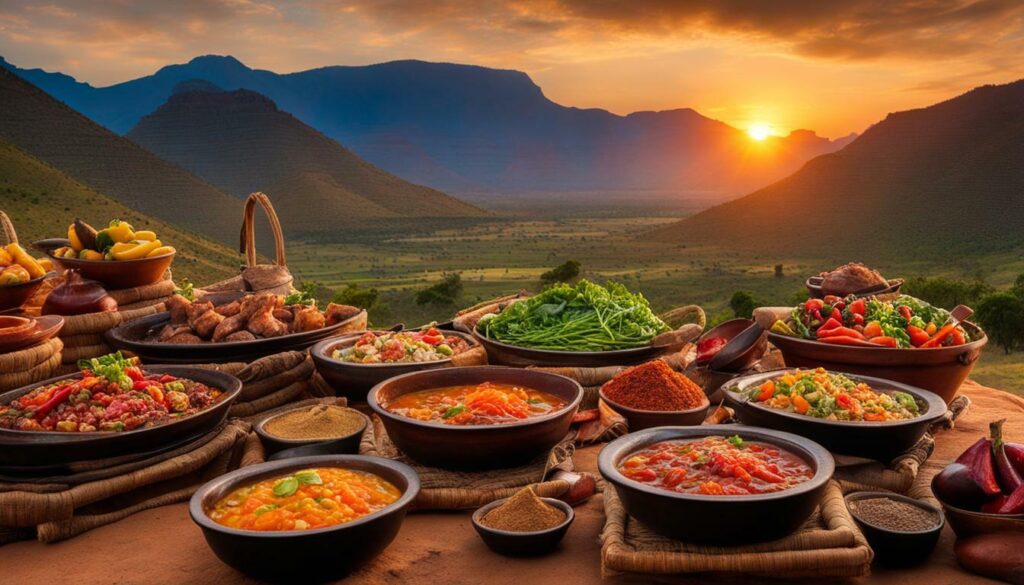
The culinary traditions of Southern Africa are a testament to the diverse cultural influences that have shaped the region’s diets throughout history. From indigenous practices to the impact of colonialism and migration, Southern African food culture is a rich tapestry of flavours, ingredients, and cooking techniques.
One of the key cultural influences on Southern African diets is the indigenous knowledge and practices of the local communities. Traditional cooking methods, such as pit cooking and the use of clay pots, have been passed down through generations and continue to be cherished and practised today. These techniques not only add unique flavours to the food but also contribute to the preservation of cultural heritage.
The legacy of colonialism is another important factor in shaping Southern African cuisine. The arrival of European settlers introduced new ingredients and cooking methods, which were blended with local traditions to create fusion dishes that are still enjoyed today. For example, dishes like bobotie, a curried meatloaf, and bredie, a slow-cooked stew, reflect the influence of Dutch, Indonesian, and Malay cooking styles.

Indigenous cooking techniques have played a significant role in shaping Southern African cuisine. One example is the traditional use of clay pots, which are believed to enhance the flavours of the food. These pots are often used for slow-cooking stews and soups, resulting in tender and flavorful dishes. Another unique cooking technique is pit cooking, where food is cooked in underground pits. This method is particularly common among the indigenous communities of Southern Africa and adds smoky and earthy flavours to the dishes.
Colonial Influences
The colonial period in Southern Africa brought new ingredients and cooking methods from Europe, Asia, and other parts of the world. Dutch settlers introduced spices and cooking techniques that influenced the Cape Malay cuisine, which incorporates flavours from Indonesia and Malaysia. The British influence brought dishes like biltong, a dried meat jerky, which originated with the indigenous Khoi people before being adopted by the settlers. Indian communities in South Africa also contributed to the culinary landscape with their distinctive curries, known for their aromatic spices and flavours.
| Indigenous Cooking Techniques | Colonial Influences |
|---|---|
| Clay pot cooking | Cape Malay cuisine |
| Pit cooking | Biltong |
| Indian curries |
The combination of these diverse culinary traditions has resulted in a vibrant and dynamic food culture in Southern Africa. Today, modern chefs and home cooks continue to draw inspiration from the past while embracing new culinary trends. The region’s culinary traditions are celebrated not only for their flavours but also for their ability to bring people together, creating a sense of unity and cultural pride.
Evolution of Southern African Diets
The diets of Southern Africa have undergone significant changes over the years, reflecting the evolving social, economic, and environmental conditions of the region. As various cultural influences merged with indigenous traditions, a diverse culinary landscape emerged, combining traditional ingredients and cooking techniques with new flavours and ingredients.
The introduction of corn, or maize, by Portuguese explorers in the 15th century had a profound impact on the diets of Southern Africans. Corn became a staple food, leading to the development of dishes like pap, a corn porridge that remains a dietary mainstay in the region. This shift from indigenous grains to corn reflected the influence of colonial powers and the changing agricultural practices in Southern Africa.
“The adoption of corn as a staple food not only transformed the dietary habits of Southern Africans but also shaped the cultural identity of the region.”

The fusion of indigenous traditions with European, Asian, and Indian influences further enriched Southern African cuisine. Dutch colonists and Javanese slaves introduced spices that are now fundamental to Cape Malay cuisine, characterized by flavorful dishes like bredie, a slow-cooked stew, and bobotie, a curried meatloaf. The Indian communities in South Africa brought with them their own distinct curries, adding a vibrant and spicy dimension to the regional cuisine.
Key Influences on Southern African Diets
An analysis of the evolution of Southern African diets reveals several key influences that have shaped the region’s culinary traditions. These influences include:
- The impact of indigenous practices is characterized by the use of local ingredients and traditional cooking techniques.
- The influence of colonialism introduced new ingredients and culinary techniques to the region.
- The migration of different ethnic groups, such as the Dutch, Javanese, and Indians, brought their own food cultures.
- The effects of globalization and urbanization, have led to the incorporation of international flavours and the diversification of Southern African diets.
The evolution of Southern African diets is an ongoing process, influenced by both historical factors and current socio-economic conditions. Understanding this evolution provides valuable insights into the region’s rich culinary heritage and the diverse flavours that continue to shape Southern African cuisine today.
| Culinary Influences | Examples |
|---|---|
| Indigenous | Use of local ingredients, traditional cooking techniques |
| Colonialism | Introduction of new ingredients, culinary techniques |
| Migration | Influence of Dutch, Javanese, Indian food cultures |
| Globalization and Urbanization | Incorporation of international flavours, diversification of diets |
“The culinary influences on Southern African diets reflect the complex history of the region and the diverse cultural tapestry that makes up its food culture.”
Historical Diets in Southern Africa
The historical diets of Southern Africa offer a glimpse into the diverse and flavoursome culinary heritage of the region, with popular dishes that have stood the test of time. Influenced by indigenous practices, colonialism, and migration, the cuisine of Southern Africa reflects the rich cultural tapestry of the region.
One of the staple foods in Southern Africa is pap, a corn porridge known as ungqushu or samp and beans. Introduced to Africa by Portuguese explorers in the 15th century, corn became the foundation of the modern black South African diet. Another iconic dish is biltong, a dried meat jerky originally made by the indigenous Khoi people and later adopted by the white settlers.
“The historical diets of Southern Africa offer a glimpse into the diverse and flavorsome culinary heritage of the region.”
Cape Malay cuisine, influenced by the spices brought by Dutch colonists and Javanese slaves, is known for its aromatic flavours. Traditional dishes like bredie, a slow-cooked stew, and bobotie, a curried meatloaf, showcase the fusion of cultures in South Africa. Indian communities in South Africa have also contributed to the culinary landscape with their distinct curries, such as the fiery mutton curries of Durban and the tantalizing prawn curry.
As for street food, South Africa offers a range of tantalizing options. Bunny chow, a hollowed-out loaf of bread filled with curry, is a popular choice, along with salomie, a Cape Malay-inspired wrap filled with meat and potatoes, and vetkoek, a deep-fried dough stuffed with various fillings.
The historical diets of Southern Africa not only provide insight into the region’s rich heritage but also highlight the ongoing challenges of food security. Millions of people in Southern Africa experience hunger and malnutrition, making it crucial to address these issues and ensure access to nutritious and culturally significant food for all.
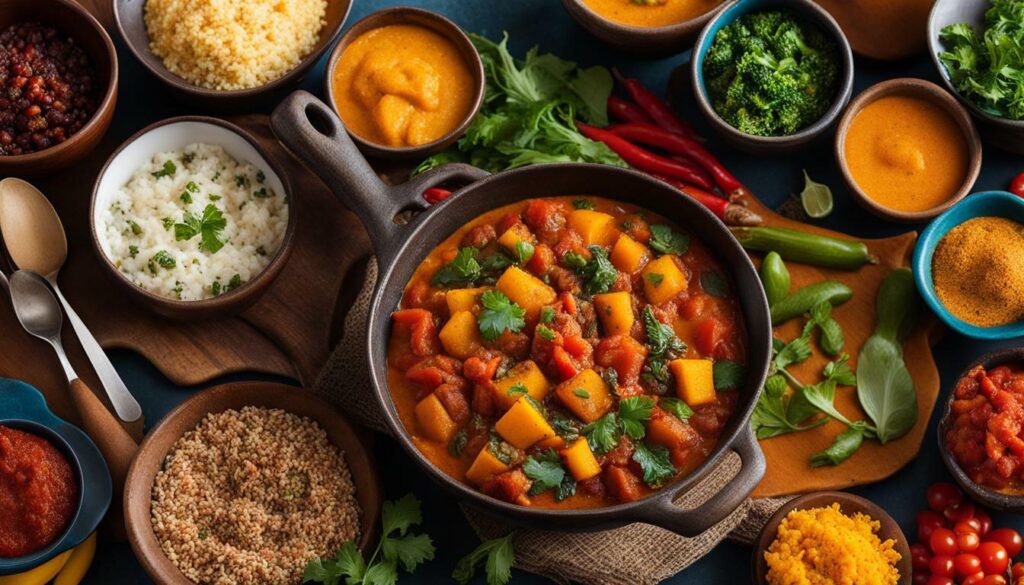
Modern Day Cuisines in Southern Africa
Modern-day cuisines in Southern Africa reflect a blend of traditional flavours and global influences, catering to the nutritional needs and preferences of the diverse population. With a rich history and cultural heritage, Southern Africa offers a tantalizing array of dishes that showcase the region’s culinary creativity. From hearty stews to aromatic curries, the cuisine of Southern Africa is a melting pot of flavours and traditions.
One of the notable aspects of modern Southern African cuisine is its emphasis on fresh, locally sourced ingredients. The region boasts an abundance of indigenous fruits, vegetables, and grains, which form the foundation of many dishes. These include staples like maize, millet, sorghum, and sweet potatoes, which provide sustenance and nutritional value to the population.
Additionally, Southern African cuisine has also embraced global influences, incorporating ingredients and cooking techniques from around the world. This fusion of flavours has resulted in a diverse culinary landscape, with dishes that blend African, European, Asian, and Indian influences. For example, the Indian community in South Africa has brought aromatic spices and curries, adding depth and complexity to the local cuisine.
“Southern African cuisine embraces the diversity of its people, combining traditional ingredients with global flavors to create a unique culinary experience.”
Furthermore, there is a growing focus on promoting sustainable practices and supporting local producers in Southern Africa. The farm-to-table movement has gained momentum, with an increasing number of restaurants and food markets showcasing the region’s rich agricultural heritage. This not only ensures the freshness and quality of ingredients but also supports local farmers and contributes to food security in the region.
By celebrating the past while embracing the present, modern-day cuisines in Southern Africa offer a delightful fusion of flavours, textures, and traditions. Whether it’s a comforting bowl of pap with a twist, a fragrant curry bursting with spices, or a vibrant salad showcasing the region’s fresh produce, Southern African cuisine continues to captivate the taste buds and tell the story of a diverse and culturally rich region.

| Traditional Ingredients | Global Influences |
|---|---|
| Maize | Indian spices |
| Sorghum | European cooking techniques |
| Millet | Asian flavours |
| Sweet potatoes | International fusion dishes |
- South African bobotie
- Zimbabwean sadza
- Malawian nsima
- Namibian kapana
The Importance of Local Ingredients
The use of locally sourced ingredients is not only a culinary choice but also a means to promote sustainable agriculture and boost the local economy. By supporting local farmers and producers, Southern African cuisines contribute to the preservation of traditional farming methods and the conservation of agricultural biodiversity. Moreover, the reliance on fresh, seasonal ingredients ensures that dishes are packed with flavour and nutritional value.
Popular Southern African Dishes
Southern Africa is known for its vibrant and delicious dishes, with a range of popular recipes that have become synonymous with the region’s culinary identity. From hearty stews to flavorful curries, Southern African cuisine offers a diverse array of flavours and ingredients. Let’s explore some of the most popular dishes that represent the rich food culture of Southern Africa.
1. Bobotie
Bobotie is a classic South African dish with Cape Malay origins. This aromatic and savoury meatloaf is made with ground beef or lamb, mixed with spices, and raisins, and topped with a layer of egg custard. It is then baked to perfection, resulting in a delicious combination of sweet and savoury flavours. Bobotie is usually served with yellow rice and sambal, a spicy condiment made from chillies and vinegar.
2. Bunny Chow
Bunny Chow is a popular street food originating from the Indian community in South Africa. It consists of a hollowed-out loaf of bread filled with a spicy curry, usually made with chicken, lamb, or beans. This dish is beloved for its bold flavours and the unique experience of eating curry-filled bread by tearing chunks of the loaf and dipping them into the sauce. Bunny Chow is a must-try when visiting South Africa.
3. Potjiekos
Potjiekos is a traditional South African stew cooked in a three-legged cast iron pot, known as a potjie. This slow-cooked dish is typically made with a variety of meats, such as beef, lamb, or game, along with an assortment of vegetables and spices. The pot is placed over an open fire, allowing the flavours to meld together and create a rich and hearty stew. Potjiekos is a favourite for social gatherings and is often enjoyed with friends and family.
These are just a few examples of the delicious and diverse dishes that make up Southern African cuisine. Each dish reflects the region’s history, cultural influences, and culinary traditions. Exploring the popular recipes and flavours of Southern Africa is a delightful journey that showcases the richness and diversity of the region’s culinary heritage.
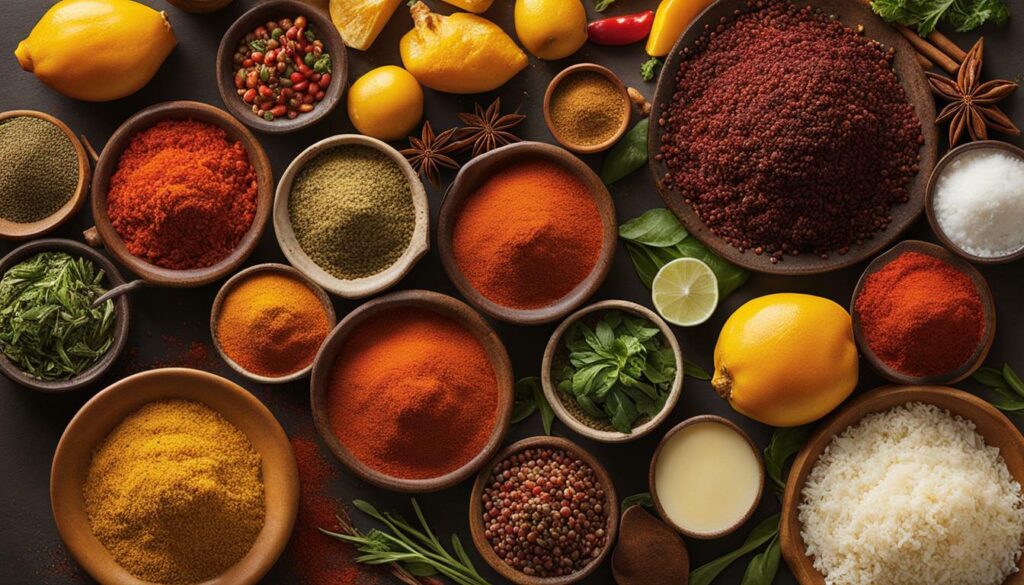
The diets of Southern Africa are not only shaped by geographical and environmental factors but also by the diverse cultural influences that have contributed to the region’s food culture. Over the centuries, Southern Africa has been home to various ethnic groups, each with their own unique culinary traditions. These cultural influences have left a lasting impact on the foods and flavours that are enjoyed throughout the region today.
One significant cultural influence on Southern African diets is the indigenous practices of the region’s native peoples. The Khoi and San communities, for example, have long relied on the indigenous plants and game of the area to sustain themselves. The use of herbs, wild fruits, and game meat continues to be celebrated in traditional Southern African cuisines.
Furthermore, the colonization and subsequent migration of different groups to Southern Africa have also played a role in shaping the region’s food culture. The arrival of European settlers introduced new ingredients, cooking techniques, and flavours to the local cuisine. Dutch, Portuguese, and British influences can still be seen in dishes such as bobotie, a South African meatloaf with Malay and Cape Dutch origins.
Indian and Southeast Asian communities, brought to Southern Africa as indentured labourers, have also made significant contributions to the region’s food culture. Durban, in particular, is known for its spicy Indian curries that are influenced by the flavours of the region. The fusion of these culinary traditions with local ingredients has resulted in a unique and vibrant food scene in Southern Africa.

Staple Foods in Southern Africa
Staple foods are the backbone of Southern African cuisine, providing sustenance and nourishment through a variety of grains, vegetables, and proteins. These ingredients have played a crucial role in the culinary tradition of the region, shaping both its history and culture.
One of the most prominent staples in Southern Africa is maize, also known as corn. Introduced to the region by Portuguese explorers in the 15th century, maize quickly became a dietary staple for many Southern Africans. It is commonly used to make pap, a thick corn porridge that serves as the foundation for many meals. Pap can be enjoyed with a variety of accompaniments such as meat, vegetables, or beans, and it remains a popular dish in Southern African households.
Another essential ingredient in Southern African cuisine is sorghum, a versatile grain that has been cultivated in the region for centuries. Sorghum is used to make porridge, bread, and traditional beer, and it is valued for its nutritional benefits and resilience in harsh climates. In addition to maize and sorghum, other staple foods in Southern Africa include millet, cassava, pumpkins, sweet potatoes, leafy greens, and a variety of legumes.
| Staple Grains | Staple Vegetables | Staple Proteins |
|---|---|---|
| Maize (Corn) | Pumpkins | Beans |
| Sorghum | Leafy Greens | Peas |
| Millet | Okra | Chickpeas |
| Cassava | Cabbage | Lentils |
These staple foods not only provide essential nutrients but also reflect the rich biodiversity and cultural diversity of the region. They are often prepared using traditional cooking methods, such as open-fire cooking or steaming, which enhance their natural flavours and textures.
The consumption of staple foods in Southern Africa is deeply rooted in local customs and traditions. They form the basis of many traditional dishes, such as bobotie, a fragrant meatloaf dish, and umngqusho, a hearty stew made with samp and beans. These dishes showcase the culinary heritage of Southern Africa and the connection between food and cultural identity.
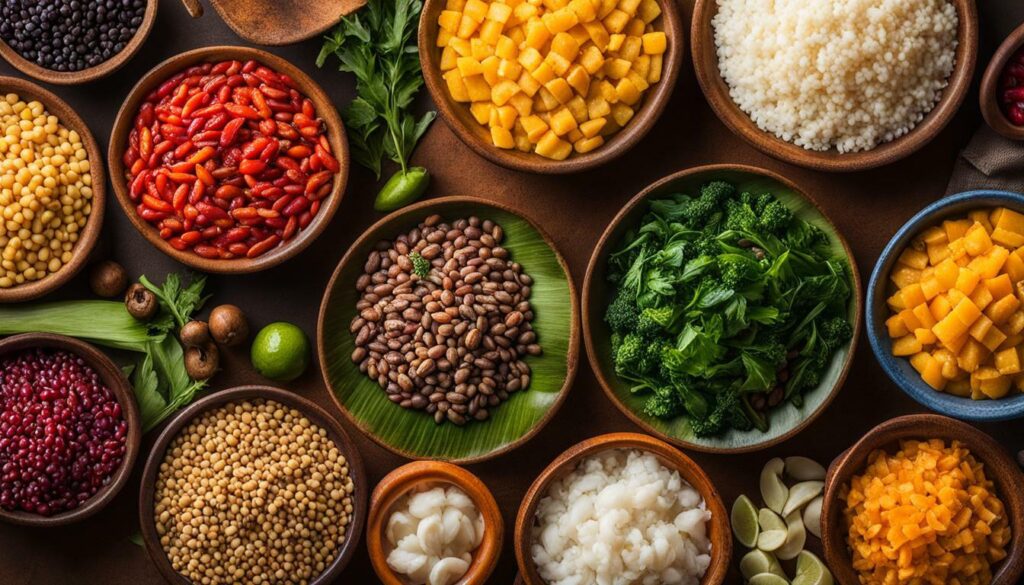
“Staple foods in Southern Africa are not just a source of sustenance, but also a reflection of our history, culture, and resilience. They are the threads that weave our diverse culinary tapestry, highlighting the dynamic flavors and traditions of the region.” – Chef Nomsa Maseko
From the humble pap to the hearty umngqusho, Southern African cuisine celebrates the abundance of the land and the resourcefulness of its people. Staple foods continue to play a vital role in nourishing communities and preserving cultural heritage. By embracing these ingredients and their culinary traditions, we can gain a deeper appreciation for the rich tapestry of flavours and the vibrant food culture of Southern Africa.
Sources:
- South African History Online – South African Food History
- Africapedia – 10 African Indigenous Staples Used in Traditional African Dishes
- The African Exponent – The 10 Staple Foods in Africa
Dietary Habits in Southern Africa
Dietary habits in Southern Africa are not merely about nourishment, but also about community, tradition, and the shared experience of enjoying a meal together. Food holds great cultural significance in Southern African societies, with meals often serving as a way to celebrate special occasions, strengthen social bonds, and pass down ancestral traditions. The region’s diverse cuisines reflect the historical influences of indigenous practices, colonialism, and migration, resulting in a unique culinary landscape.
Traditional Southern African diets are centred around staple foods such as maize, sorghum, millet, and beans. These ingredients form the base of many dishes, providing sustenance and nutritional value. The preparation of meals often involves communal cooking, with family and friends gathering to share the tasks of grinding, pounding, and cooking. This process reinforces the sense of community and togetherness that is deeply ingrained in Southern African food culture.
Table: Traditional Southern African Staple Foods
| Food | Region | Cultural Significance |
|---|---|---|
| Pap | South Africa | A staple corn porridge enjoyed by many communities. |
| Ugali | Zimbabwe, Malawi, Tanzania | A thick maize meal popular across multiple countries. |
| Sadza | Zimbabwe | A cornmeal dish often served with stew or soup. |
| Phaleche | Botswana | A sorghum porridge traditionally cooked in a three-legged pot. |
The dietary habits of Southern Africans also encompass a wide range of traditional dishes, each with its unique flavours and cultural significance. Meat, particularly beef, goat, and chicken, plays a prominent role in many meals, often accompanied by vegetables, herbs, and spices. Indigenous vegetables such as morogo (wild spinach), imifino (pumpkin leaves), and mavunda (cowpea leaves) are commonly used in traditional cooking, providing important sources of vitamins and minerals.
Furthermore, the influence of globalization has introduced new food choices and dietary habits in Southern Africa. Urbanization has increased the accessibility of processed and convenience foods, leading to changes in consumption patterns. However, there is also a growing movement to promote local ingredients, sustainable farming practices, and healthier eating habits. This reflects a desire to preserve traditional food cultures while adapting to modern lifestyles.

As the region continues to evolve, the preservation and celebration of its diverse dietary habits remain essential. Southern African food culture holds a wealth of history, symbolism, and community values, making it a significant part of the region’s identity. Exploring the past and present diets of Southern Africa not only provides insight into the culinary traditions but also offers a deeper understanding of the people and cultures that call this region home.
Southern Africa Food Culture Today
The food culture in Southern Africa today is a vibrant tapestry of diverse flavours, culinary innovation, and a celebration of local ingredients. With its rich history and cultural influences, Southern African cuisine has evolved to showcase a unique fusion of traditional recipes and modern influences. From the indigenous dishes of the past to the contemporary creations of renowned chefs, the region offers a culinary experience that is sure to delight any food enthusiast.
One notable aspect of Southern African food culture is the emphasis on fresh, locally sourced ingredients. In recent years, there has been a growing movement to promote sustainable farming practices and support local farmers. This has led to an increased availability of organic produce, artisanal cheeses, and free-range meats, allowing for a farm-to-table dining experience.
Furthermore, the region’s diverse cultural influences have contributed to an array of culinary traditions. The fusion of indigenous practices, colonial history, and the influence of immigrants has given rise to a melting pot of flavours. From the aromatic spices of Indian curries to the hearty stews of Cape Malay cuisine, there is a dish to suit every palate.
To fully appreciate the depth and variety of Southern African cuisine, it is worth exploring the popular dishes that have become culinary icons in the region. These include the famous South African braai, a traditional barbecue featuring marinated meats and delicious side dishes. Another beloved dish is the fragrant Mozambican peri-peri chicken, known for its spicy flavours and succulent meat.
To get a taste of Southern African cuisine, consider sampling some of these dishes at local restaurants or even trying your hand at cooking them yourself. The culinary heritage of Southern Africa is an integral part of its cultural identity and should be celebrated and shared with the world.
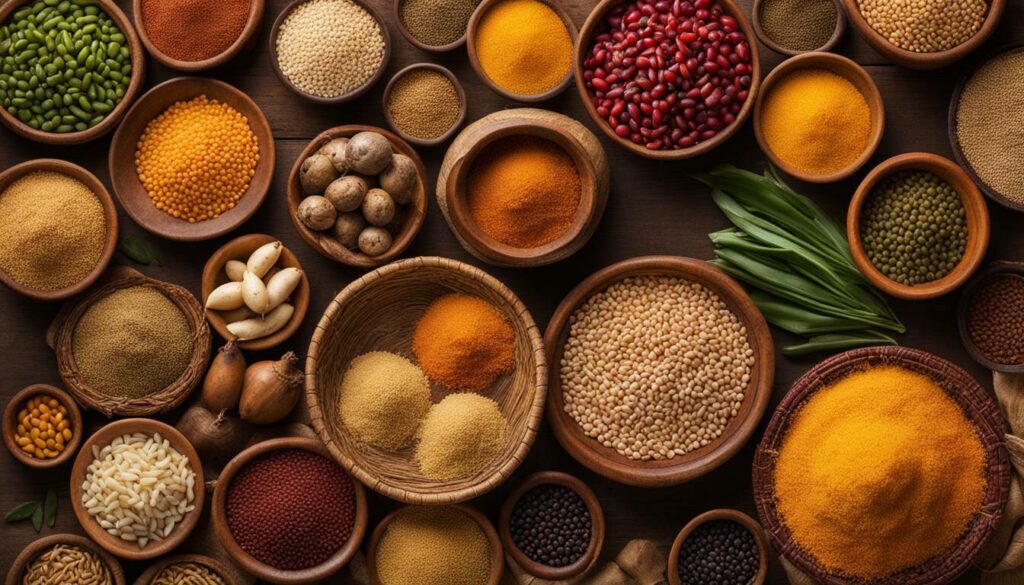
| Dish | Origin | Description |
|---|---|---|
| Bobotie | Cape Malay | A spiced meatloaf baked with an egg-based topping, served with yellow rice and chutney. |
| Bunny Chow | Durban | A hollowed-out loaf of bread filled with curry, typically made with mutton or beans. |
| Chakalaka | Soweto | A spicy vegetable relish made with tomatoes, onions, and various spices, often served as a side dish. |
| Oxtail Potjie | Afrikaans | A slow-cooked stew made with oxtail, vegetables, and aromatic herbs and spices. |
Conclusion
Exploring the past and present diets of Southern Africa reveals a captivating journey through time, showcasing the intricate blend of history, culture, and flavours that make the region’s cuisine truly unique. Southern African food culture is deeply rooted in the historical experiences of its diverse communities, with each dish telling a story of resilience, adaptation, and fusion.
The staple foods of Southern Africa, such as the corn-based porridge known as pap, reflect the impact of European colonization and the introduction of new ingredients. Indigenous culinary traditions, like the Khoi’s dried meat jerky known as biltong, have also left their mark on the region’s cuisine. The influence of Asian, Indonesian, and Indian flavours brought by immigrants and slaves further adds to the rich tapestry of Southern African dishes.
Today, Southern African cuisine continues to evolve, embracing global influences while staying true to its roots. The fusion of traditional ingredients and modern cooking techniques can be seen in the vibrant culinary scenes of major cities, where chefs experiment with both familiar and innovative flavours. However, food security remains a pressing issue in the region, with many people facing hunger and malnutrition. Addressing this challenge requires a holistic approach that combines sustainable agricultural practices, equitable distribution of resources, and cultural preservation.
As we conclude this exploration of Southern African diets, we are left with a deep appreciation for the diversity and resilience of the region’s food culture. From the traditional dishes that have stood the test of time to the emerging culinary trends that shape the present, Southern Africa’s cuisine is a testament to the power of food to connect, nourish, and celebrate. So, let us savour the flavours, embrace the stories, and continue to explore the vibrant world of Southern African cuisine.
FAQ
What are some traditional foods in Southern Africa?
Traditional foods in Southern Africa include staple dishes like pap (corn porridge), biltong (dried meat jerky), bredie (slow-cooked stew), bobotie (curried meatloaf), and various curries influenced by Indian communities.
How have cultural influences shaped Southern African diets?
Cultural influences, such as indigenous practices, colonialism, and migration, have all played a role in shaping Southern African diets over time. These influences have led to a diverse culinary landscape with a fusion of flavours and cooking techniques.
What factors have contributed to the evolution of Southern African diets?
The evolution of Southern African diets has been influenced by globalization, urbanization, and socioeconomic factors. These factors have led to changes in ingredients, cooking techniques, and dietary habits.
What are some popular Southern African dishes?
Some popular Southern African dishes include pap (corn porridge), bobotie (curried meatloaf), bunny chow (hollowed-out bread filled with curry), and various curries influenced by Indian communities.
What are the staple foods in Southern Africa?
Staple foods in Southern Africa include corn, sorghum, millet, beans, and various vegetables. These ingredients form the basis of many traditional dishes in the region.
What are the dietary habits in Southern Africa?
Southern Africans have traditional eating patterns, meal structures, and a strong emphasis on communal dining. Food plays an important role in social gatherings and celebrations, fostering a sense of community.
What is the current food culture like in Southern Africa?
The current food culture in Southern Africa showcases a fusion of traditional and modern influences. Major cities have dynamic culinary scenes that incorporate local ingredients and sustainable practices, reflecting a growing interest in promoting regional cuisine.
What is the significance of food in Southern African culture?
Food holds cultural significance in Southern Africa, representing heritage, traditions, and social connections. Traditional dishes are often tied to specific ethnic groups and are enjoyed during special occasions and celebrations.
How is food security addressed in Southern Africa?
Food security is a concern in Southern Africa, with millions of people experiencing hunger and malnutrition. Efforts are being made to address this issue through initiatives that promote sustainable agriculture, access to nutritious food, and community development.
What is the historical background of food in Southern Africa?
Food in Southern Africa has a historical background shaped by violent conquest and oppression. Staple foods like corn porridge and dried meat jerky have indigenous and colonial influences, reflecting the region’s complex history.
Source Links
- https://journals.openedition.org/afriques/1857
- https://explorepartsunknown.com/south-africa/the-bittersweet-and-spicy-history-of-south-african-cuisine/
- https://www.ncbi.nlm.nih.gov/pmc/articles/PMC5567909/
Read Our Articles On The Other Regions of Africa Here:
| Past and Present Diets of North Africa |
| Past and Present Diets of West Africa |
| Past and Present Diets of East Africa |
| Past and Present Diets of Central Africa |
| Past and Present Diets Sub-Saharan Africa |



